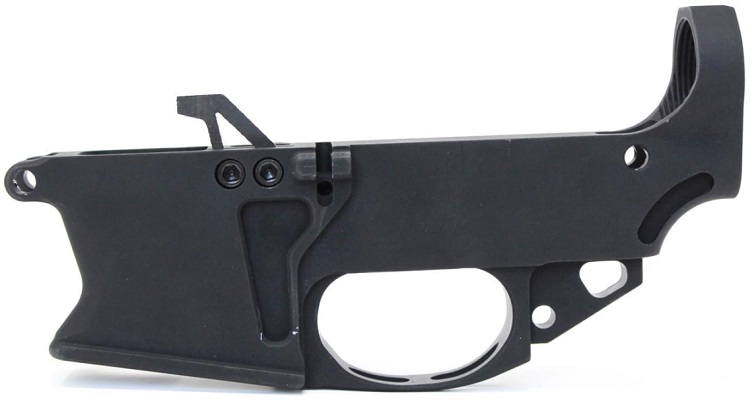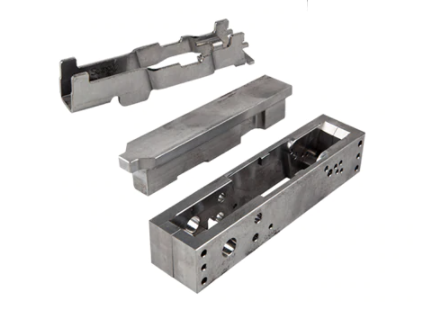All Types of 80 Percent Lowers & Frames
Posted by Gun Builders Depot on Sep 9th 2020
With so many options available, pick the right lower for an 80% gun build can seem overwhelming. We're comparing all 80% lowers for every platform, including all AR lowers and handgun frames. We'll also break down everything you need to know to choose your receiver, like material, caliber, coating or finish, parts compatibility, and tools required to build the thing. By the end of this guide, you'll know everything there is to know about 80% lowers for most weapons, and which one is best for your AR-type rifle or pistol, or handgun. (New? Start here.)
Types of 80 Percent Lowers
An 80 percent lower can be made from four different materials: Billet aluminum, forged aluminum, polymer, and cast aluminum.
Billet AR-15 (6061-T6 aluminum)
Billet 80% lowers are cut from a large solid block of aluminum stock and machined into shape using a CNC. These lowers can be designed with complex shapes. Thanks to CNC, they can also feature things like integrated trigger guards and threaded fittings. Fabricating billet aluminum is more expensive than forging or casting a lower, so the retail cost of a billet 80 percenter is usually a little higher compared to other options.
Pros
- Compatible with most jigs
- Less wear on jig and tooling
- Quicker to machine than forged
- Features threaded fittings for easier assembly
Cons
- More susceptible to machining mistakes
- More expensive than forged or polymer receivers
- Softer than forged lower, more prone to scratching
Available Calibers:
- 5.56 NATO, .223 Remington, 6.5 Grendel, 6.8 SPC
Available finishes:
- Raw (uncoated)
- Type III Hardcoat Anodized
Forged AR-15 (7075-T6 aluminum)
Forged lowers are made by pouring molten aluminum into a mold. The lower is then pressed into its final shape using extreme heat and pressure. Forged lowers are less expensive to make than billet, so they cost less. They're also the most rugged and can take the most abuse of any AR-type receiver. The U.S. Military uses forged receivers in their service rifles for this reason. The chemical composition of a forged receiver is similar but different than billet.
Pros
- Compatible with most 80% jigs
- More affordable than billet lower
- The most popular choice for builders
- More forgiving with minor machining mistakes
- The most durable type of 80 lower receiver
Cons
- No threaded fittings (traditional roll pins)
- Exerts more wear on jig and tooling
- Machining takes longer than billet
- More assembly may be required (trigger guard)
Available Calibers:
- 5.56 NATO, .223 Remington, .308 Winchester, 9mm, 6.5 Grendel, 6.5 Creedmoor, 6.8 SPC
Available finishes:
- Raw (uncoated)
- Type III Hardcoat Anodized
Billet LR-308 ("AR-10", 6061-T6)
A larger variant of the AR-15, the LR-308 platform from DPMS Panther Arms has an 80% lower available for builders who want to chamber .30-caliber rounds like .308 Winchester. This receiver is also required for AR-10 clones and 6.5 Creedmoor builds. It's fabricated from billet aluminum like many AR-15 lower receivers. Many builders refer to rifles built with the LR-308 lower as an AR-10, but this is not technically correct. The original ArmaLite AR-10 rifle is almost exclusively made available for military use and average 5 to 7 times more in cost. This lower is not compatible with AR-10 or ArmaLite-branded .308 parts.

Pros
- Capable of chambering .308
- Perfect for long-range AR builds
- More affordable than original AR-10 platform
- Features threaded fittings like its AR-15 variant
Cons
- More expensive than .22-caliber AR builds
- Not compatible with original ArmaLite parts
Available Calibers:
- .308 Winchester, 6.5 Creedmoor
Available finishes:
- Raw (uncoated)
- Type III Hardcoat Anodized
Billet AR9 (6061-T6)
Pistol-caliber carbines have become popular in recent years, and many shooters have decided to use the AR platform to build one. The AR9 is the official 9mm variant of the AR-15, and an 80% lower has been developed specifically for the blowback pistol cartridge. It's made from the same billet aluminum used in other receivers and sports the same anodized coating. This lower receiver uses AR-15 parts, making it an easy method for building a 9mm AR.

Pros
- Compatible with most AR-15 jigs
- Compatible with AR-15 lower parts
- Uses a regular buffer tube and brace/stock
- Uses a regular AR-15 recoil spring
Cons
- More expensive than .22-caliber AR builds
- Not compatible with original ArmaLite parts
Available Calibers:
- 9mm Parabellum
Available finishes:
- Type III Hardcoat Anodized
Here's how to complete an aluminum 80% AR lower.
Polymer AR-15 (nylon-reinforced)
The polymer lower is relatively new, but they're the most affordable choice for any 80% AR build. These lowers are made of nylon-reinforced polymer, like a typical GLOCK or sub machinegun. This polymer was reinforced to safely handle supersonic rifle rounds (like .223, 5.56, and .308), using a nylon-reinforced core to prevent cracking or failure under abuse. When fabricated, this receiver weighs about half as much as an aluminum receiver. Hundreds of builders have used a polymer lower to build an ultra-light AR. This guide compares polymer and aluminum receivers.
Pros
- The most affordable 80 lower
- Includes its own, proprietary jig
- The easiest and quickest to machine
- Includes its own 80 lower jig
- Can be finished with hand tools
Cons
- Most prone to scratches and surface wear
- Less durable compared to billet and forged
- The jig is usually sacrificed while machining
Available Calibers:
- 5.56 NATO, .223 Remington, .308 Winchester, 9mm, 6.5 Grendel, 6.5 Creedmoor, 6.8 SPC
Available finishes:
- Natural (black)
- Flat Dark Earth
Cast (A380 aluminum)
Cast lowers are technically a fourth available option, though we strongly recommend against using one to build your AR-15. Cast lowers are made by pouring A380 aluminum alloy into a mold. The lower is then left to harden into its final shape (no forging). This process can cause defects and imperfections. Cast lowers can contain hidden pockets, small cracks, or fissures. While machining or firing your AR with a cast lower, these imperfections could cause a catastrophic failure. The result is usually dangerous to the shooter and can result in injury or death.

An example of a cast lower.
Pros
- None
Cons
- Can suffer poor build quality
- May contain dangerous imperfections
- Can crack or break while machining
- Can cause catastrophic failure when fired
Types of 80% Frames
The AR platform is not the only weapon available to 80% builders. Now, popular handguns like the 1911 and GLOCK have 80% frames that mirror those guns' factory frames in fit and finish. Fabricating one is typically easier than completing an AR's lower, making the 80% pistol attractive to first-time builders and shooters who only have basic tools at their disposal.
Billet 1911 (6061-T6)
The 1911 used a steel frame because that was the only material that could work reliably over a hundred years ago. Today, there's little reason to shove a heavy steel frame into the 1911, so 80% makers developed a billet aluminum frame blank. The frame works with all 1911 parts and comes in the Government (5") and smaller Commander (4.25") sizes. Frames can be bought "slick" or with an underside Picatinny accessory rail.

Pros
- 50% lighter than a steel frame
- Works with all retail 1911 parts
- Easily machined with hand tools
- Affordable way to build a custom piece
Cons
- Not available in Officer (3.5") variant
Available Calibers:
- .45 ACP, 9mm Parabellum
Available finishes:
- Raw (uncoated)
- Type III Hardcoat Anodized
Here's a guide on completing the 1911 frame.
Polymer GLOCK-Compatible (Nylon-reinforced)
Arguably the most successful 80% firearm receiver of all time, Polymer80's GLOCK-compatible frames are also some of the easiest guns to build for new builders. They're compatible with most of GLOCK's makes, models, and calibers. They ship with the finishing jig and bits, making them a great value for those who want to test out finishing an 80% build for the first time. These frames work with all factory and aftermarket GLOCK parts, but use their own locking block and rear rail module for installing the trigger mechanism, slide, and barrel.Pros
- Works with all GLOCK models
- Includes the finishing jig and tools
- The easiest 80 percenter to build
Cons
- Requires sanding and fine-tuning for initial assembly
Available Glock Models:
- G17, 19, 22, 23, 24, 26, 27, 31, 32, 34, 35, and others
Available finishes:
- Black
- Green
- FDE
Here's how to complete a P80 frame.
Steel P320 80% Chassis (316 Stainless)
The Sig Sauer P320 is a modular handgun that can be made into dozens of variants in size and caliber. The firearm component of the P320 is not the frame itself (which is called a "grip module"). A self-contained steel chassis that hosts the trigger, hammer, sear, disconnector, safety, and striker acts like one big drop-in firearm that receives an exoskeleton to function. It's an amazing design that's perfect for the 80 percenter to get more guns in one. Fabricating the 80% chassis for the P320 is more difficult than cutting a polymer frame. But it still only requires a Dremel or handheld cutter, a hand drill, a vise, and a little patience.

Pros
- Perfect clone of the P320 chassis
- Works with all P320 parts and calibers
- Includes finishing jig and parts kit to build
- Requires hand tools, no specialty equipment
Cons
- Most difficult 80% handgun/frame to machine
Available Calibers:
- 9mm, .40 S&W, .357 SIG, .45 ACP
Available Sizes:
- Full (4.7" barrel)
- Carry (3.9" barrel)
- Compact (3.9" barrel)
- Subcompact (3.6" barrel)
Here's how to build the 80% Sig P320.
Recap & FAQ
Lowers and frames are categorized by their weapon platform. AR-type lowers make up a bulk of the market, with various 80% frames comprising the other half. Polymer receivers and handgun frames can be fabricated with little more than a hand drill and a handheld cutting tool. Aluminum lowers for the AR platform require a drill press or mill to fabricate.
Q: Are 80% lowers legal?
A: Yes. Under federal law, these are legal to own. Here's a guide covering 80% lower laws, including state laws and which states have banned them.
Q: How do you complete one of these?
A: It's easy. In addition to some hand tools, you'll need something called a jig. It does most of the work and eliminates the need for measuring and fabricating with complex machinery. Here's an in-depth guide on jigs.
Q: What are all the available builds I can do?
A: 80 percent lowers and frames have been made for the AR-15, AR9, LR-308, 1911, GLOCK, and Sig Sauer P320. New manufacturers are developing new types all the time, so check back for more later.
Q: What other tools do I need for this project?
A: That depends on the type of lower or frame. This guide covers tools that are required and recommended for each type.
DISCLAIMER: If you are new to the world of DIY gun building, you likely have a lot of questions and rightfully so. It’s an area that has a lot of questions that, without the correct answers, could have some serious implications. At GunBuilders.com, we are by no means providing this content on our website to serve as legal advice or legal counsel. We encourage each and every builder to perform their own research around their respective State laws as well as educating themselves on the Federal laws. When performing your own research, please be sure that you are getting your information from a reliable source.



